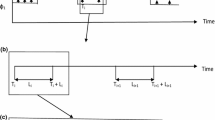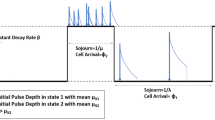Abstract
Stochastic point processes for rainfall are known to be able to preserve the temporal variability of rainfall on several levels of aggregation (e.g. hourly, daily), especially when the cluster approach is used. One major assumption in most of the applications todate is the stationarity of the rainfall properties in time, which must be reconsidered under a climate change hypothesis. Here, we propose new theoretical developments of a Poisson-based model with cluster, namely the Neyman–Scott Rectangular Pulses Model, which treats storm frequency as a nonstationary function. In this paper, storm frequency is modelled as a linear function of time in order to reproduce an increase (or decrease) of the mean annual precipitation. The basic theory is reconsidered and the moments are derived up to the third order. Then, a calibration method based on the generalized method of moments is proposed and discussed. An application to a rainfall time series from Uccle illustrates how this model can reproduce a trend for the average rainfall. This work opens new avenues for future developments on transient stochastic rainfall models and highlights the major challenges linked to this approach.











Similar content being viewed by others
Notes
The Matlab code containing all the expressions not presented here is available upon request.
See de Jongh et al. (2006), where the conclusions change when two additional years are used to calculate the trends.
References
Burton A, Kilsby C, Fowler H, Cowpertwait P, O’Connell P (2008) Rainsim: a spatial-temporal stochastic rainfall modelling system. Environ Model Softw 23(12):1356–1369. doi:10.1016/j.envsoft.2008.04.003
Burton A, Fowler H, Blenkinsop S, Kilsby C (2010) Downscaling transient climate change using a Neyman–Scott rectangular pulses stochastic rainfall model. J Hydrol 381(1-2):18–32. doi:10.1016/j.jhydrol.2009.10.031
Cameron D, Beven K, Tawn J (2000) An evaluation of three stochastic rainfall models. J Hydrol 228(1–2):130–149. doi:10.1016/S0022-1694(00)00143-8
Ceresetti D, Molinié G, Creutin JD (2010) Scaling properties of heavy rainfall at short duration. A regional analysis. Water Resour Res 46(W09531). doi:10.1029/2009WR008603
Cowpertwait P, O’Connell P, Metcalfe A, Mawdsley J (1996) Stochastic point process modelling of rainfall. I. Single-site fitting and validation. J Hydrol 175(1–4):17–46. doi:10.1016/S0022-1694(96)80004-7
Cowpertwait PSP (1994) A generalized point process model for rainfall. Proc R Soc Lond A Math Phys Eng Sci 447(1929):23–37. doi:10.1098/rspa.1994.0126
Cowpertwait PSP (1998) A Poisson-cluster model of rainfall: high-order moments and extreme values. Proc R Soc Lond A Math Phys Eng Sci 454:885–898. doi:10.1098/rspa.1998.0191
Cowpertwait PSP, Isham V, Onof C (2007) Point process models of rainfall: developments for fine-scale structure. Proc R Soc Lond A Math Phys Eng Sci 463(2086):2569–2587. doi:10.1098/rspa.2007.1889
Cowpertwait PSP, Xie G, Isham V, Onof C, Walsh DCI (2011) A fine-scale point process model of rainfall with dependent pulse depths within cells. Hydrol Sci J 56(7):1110–1117. doi:10.1080/02626667.2011.604033
Cox DR, Isham V (1980) Point processes. Monographs on applied probability and statistics. Chapman & Hall, London
de Jongh ILM, Verhoest NEC, de Troch FP (2006) Analysis of a 105-year time series of precipitation observed at Uccle, Belgium. Int J Climatol 26:2023–2039
Demarée, G R (2003) Le pluviographe centenaire du plateau d’Uccle: son histoire, ses données et ses applications. The centennial recording Raingauge of the Uccle Plateau: its History, its Data and its Applications. La Houille Blanche (4):95–102
Dunn P (2004) Occurrence and quantity of precipitation can be modelled simultaneously. Int J Climatol 24:1231–1239. doi:10.1002/joc.1063
Entekhabi D, Rodriguez-Iturbe I, Eagleson P (1989) Probabilistic representation of the temporal rainfall process by a modified Neyman–Scott rectangular pulses model: Parameter estimation and validation. Water Resour Res 25(2):295–302
Evin G, Favre AC (2008) A new rainfall model based on the Neyman–Scott process using cubic copulas. Water Resour Res 44(W03433). doi:10.1029/2007WR006054
Favre AC, Musy A, Morgenthaler S (2004) Unbiased parameter estimation of the Neyman–Scott model for rainfall simulation with related confidence interval. J Hydrol 286(1–4):168–178. doi:10.1016/j.jhydrol.2003.09.025
IPCC (2007) IN: Solomon S, Qin D, Manning M, Chen Z, Marquis M, Averyt KB,Tignor M, Miller HL (eds) Climate change 2007—the physical science basis: working group I contribution to the fourth assessment report of the IPCC (climate change 2007). Cambridge University Press, Cambridge. http://www.ipcc-wg1.unibe.ch/publications/wg1-ar4/wg1-ar4.html Last visited July, 2010
Jennings SA, Lambert MF, Kuczera G (2010) Generating synthetic high resolution rainfall time series at sites with only daily rainfall using a master-target scaling approach. J Hydrol 393(3–4):163–173. doi:10.1016/j.jhydrol.2010.08.013
Maronna RA, Martin RD, Yohai VJ (2006) Robust statistics: theory and methods. Wiley series in probability and statistics. Wiley, Chichester
Molnar P, Burlando P (2005) Preservation of rainfall properties in stochastic disaggregation by a simple random cascade model. Atmos Res 77(1–4):137–151. doi:10.1016/j.atmosres.2004.10.024
Ntegeka V, Willems P (2008) Trends and multidecadal oscillations in rainfall extremes, based on a more than 100-year time series of 10 min rainfall intensities at Uccle, Belgium. Water Resou Res 44(W07402). doi:10.1029/2007WR006471
Onof C, Chandler RE, Kakou A, Northrop P, Wheater HS, Isham V (2000) Rainfall modelling using Poisson-cluster processes: a review of developments. Stoch Env Res Risk Assess 14(6):384–411. doi:10.1007/s004770000043
Rodriguez-Iturbe I, Cox DR, Isham V (1987) Some models for rainfall based on stochastic point processes. Proc R Soc Lond A Math Phys Eng Sci 410(1839):269–288. doi:10.1098/rspa.1987.0039
Rousseeuw PJ, Leroy AM (1987) Robust regression and outlier detection. Wiley series in probability and mathematical statistics: applied probability and statistics. Wiley, New York
Sansó B, Guenni L (2000) A nonstationary multisite model for rainfall. J Am Stat Assoc 95(452):1089–1100
Schertzer D, Lovejoy S (2004) Space-time complexity and multifractal predictability. Phys Stat Mech Appl 338(1-2):173–186. doi:10.1016/j.physa.2004.04.032
Sharma A, Mehrotra R (2010) Rainfall generation. In: Testik FY, Gebremichael M (eds) Rainfall: state of the science. Geophysical monograph series, vol 191. AGU, Washington, pp 215–246. doi:10.1029/2010GM000973
Stern RD, Coe R (1984) A model fitting analysis of daily rainfall data. J R Stat Soc A (Gen) 147(1):1–34
Vandenberghe S, Verhoest NEC, De Baets B (2010) Fitting bivariate copulas to the dependence structure between storm characteristics: a detailed analysis based on 105 year 10 min rainfall. Water Resour Res 46(W01512). doi:10.1029/2009WR007857
Velghe T, Troch PA, De Troch FP, Van de Velde J (1994) Evaluation of cluster-based rectangular pulses point process models for rainfall. Water Resour Res 30:2847–2857
Verhoest N, Troch PA, De Troch FP (1997) On the applicability of bartlettlewis rectangular pulses models in the modeling of design storms at a point. J Hydrol 202(1–4):108–120. doi:10.1016/S0022-1694(97)00060-7
Verhoest NEC, Vandenberghe S, Cabus P, Onof C, Meca-Figueras T, Jameleddine S (2010) Are stochastic point rainfall models able to preserve extreme flood statistics? Hydrol Process 24(23):3439–3445. doi:10.1002/hyp.7867
Westra S, Sisson S (2011) Detection of non-stationarity in precipitation extremes using a max-stable process model. J Hydrol 406(1–2):119–128. doi:10.1016/j.jhydrol.2011.06.014
Acknowledgements
The authors would like to thank two anonymous referees for their thorough reviews and constructive comments.
Author information
Authors and Affiliations
Corresponding author
Appendix: General expressions of the moments
Appendix: General expressions of the moments
1.1 First order moment
Random variables \({X_{t-u}(u)}\) and \({\mathrm{d}} {N(t-u)}\) are usually independent. It means that the properties linked to the point generation do not influence the cell characteristics. In particular, the mean rainfall intensity at time \({t}\) is
From Cox (1980, p. 75), we obtain \({{\mathbb E}\{N(t,t+\delta)\} = \mu_C \varphi(t) \delta,}\) so that
Note that, to obtain \({{\mathbb E}\{X_{t-u}(u)\}}\) and then a complete expression for \({{\mathbb E}\{Y(t)\},}\) a bivariate distribution on cell intensity and duration needs to be specified. The mean of the aggregated process \({Y_i^h}\) is
1.2 Second order moment
To derive the second-order properties of the aggregated process, we need to express the covariance function of the point process \({c(t,u)={\mathbb{C}}{\text{ov}}\big\{N(t,t+\delta_1),N(t+u,t+u+\delta_2)\big\}.}\) According to Cox and Isham (1980, p. 33), the covariance of the counting process between \({t_1}\) and \({t_2}\) is
Following Cox and Isham (1980, p. 77), two points located at \({t_1}\) and \({t_2 \,>\,_1}\) may
-
1.
belong to different clusters, in which case they are independent,
-
2.
belong to the same cluster with center \({t_c.}\)
The way in which cells are distributed in time can differ depending on whether the Neyman–Scott or Bartlett–Lewis process is studied. In the basic version of the Neyman–Scott process, cell origins are independently separated from storm origins by distances which are exponentially distributed with parameter \({\beta. }\) We have
Consequently, the covariance between two points at \({t}\) and \({t+u}\) is
The Bartlett–Lewis process distributes cell origins according to a Poisson process with rate \({\beta, }\) the storm activity having a random duration which is exponentially distributed with parameter \({\gamma. }\) We obtain in this case
When \({u=0, }\) we have
Note that (8) is valid for both Neyman–Scott and Bartlett–Lewis processes.
The autocovariance of the instantaneous rainfall intensity \({Y(t)}\) with lag \({\tau}\) can be expressed as Rodriguez-Iturbe et al. (1987, Eq.3.2) in terms of the covariance function \({c(t,u){:}}\)
Finally, the second-order properties of the aggregated process are obtained as
and
Rights and permissions
About this article
Cite this article
Evin, G., Favre, AC. Further developments of a transient Poisson-cluster model for rainfall. Stoch Environ Res Risk Assess 27, 831–847 (2013). https://doi.org/10.1007/s00477-012-0612-y
Published:
Issue Date:
DOI: https://doi.org/10.1007/s00477-012-0612-y




